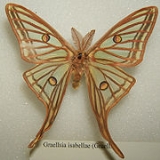
Graellsia isabellae
Encyclopedia
The Spanish Moon Moth, Graellsia isabellae, is a moth
of the silkmoth family Saturniidae
.
and France
.
At the end of April and beginning of May the moth begins to hatch after overwintering in the cocoon.
Normally moths from the same line don't copulate, so it is the condition that different lines are in a not too wide range.
After copulation the female lays about 100 to 150 eggs on the favoured foodplant, pines.
The larva hatch after 1 to 1.5 weeks a still begin to eat from the very hard pine needles.
It takes about 1.5 month to see the last instar of the caterpillars.
In the last instar the caterpillars go down from the tree to pupate under leaves on the ground. In this phase the pupae in the cocoon overwinters until next springtime.
). It appears to have difficulty adopting non-native pine species as a host even within the Pinus genus.
Moth
A moth is an insect closely related to the butterfly, both being of the order Lepidoptera. Moths form the majority of this order; there are thought to be 150,000 to 250,000 different species of moth , with thousands of species yet to be described...
of the silkmoth family Saturniidae
Saturniidae
The Saturniidae, commonly known as saturniids, are among the largest and most spectacular of the moths. They form a family of Lepidoptera, with an estimated 1,300 to 1,500 described species worldwide...
.
Range
The moth is native to SpainSpain
Spain , officially the Kingdom of Spain languages]] under the European Charter for Regional or Minority Languages. In each of these, Spain's official name is as follows:;;;;;;), is a country and member state of the European Union located in southwestern Europe on the Iberian Peninsula...
and France
France
The French Republic , The French Republic , The French Republic , (commonly known as France , is a unitary semi-presidential republic in Western Europe with several overseas territories and islands located on other continents and in the Indian, Pacific, and Atlantic oceans. Metropolitan France...
.
At the end of April and beginning of May the moth begins to hatch after overwintering in the cocoon.
Normally moths from the same line don't copulate, so it is the condition that different lines are in a not too wide range.
After copulation the female lays about 100 to 150 eggs on the favoured foodplant, pines.
The larva hatch after 1 to 1.5 weeks a still begin to eat from the very hard pine needles.
It takes about 1.5 month to see the last instar of the caterpillars.
In the last instar the caterpillars go down from the tree to pupate under leaves on the ground. In this phase the pupae in the cocoon overwinters until next springtime.
Host plants
This moth primarily eats the needles of pine trees (PinusPine
Pines are trees in the genus Pinus ,in the family Pinaceae. They make up the monotypic subfamily Pinoideae. There are about 115 species of pine, although different authorities accept between 105 and 125 species.-Etymology:...
). It appears to have difficulty adopting non-native pine species as a host even within the Pinus genus.
Sources
- World Conservation Monitoring Centre 1996. Graellsia isabelae. 2006 IUCN Red List of Threatened Species. Downloaded on 31 July 2007.
External links
- Photos
- http://www.nhm.ac.uk/jdsml/research-curation/research/projects/lepindex/detail.dsml?TaxonNo=68001.0&UserID=&UserName=&&listPageURL=list.dsml%3fsort%3dSCIENTIFIC%255fNAME%255fon%255fcard%26SCIENTIFIC_NAME_on_cardqtype%3dstarts%2bwith%26SCIENTIFIC_NAME_on_card%3disabellae%26recLimit%3d30&searchPageURL=index.dsml%3fSCIENTIFIC_NAME_on_cardqtype%3dstarts%2bwith%26sort%3dSCIENTIFIC%255fNAME%255fon%255fcard%26SCIENTIFIC_NAME_on_card%3disabellae%26recLimit%3d30Lepindex entry]

